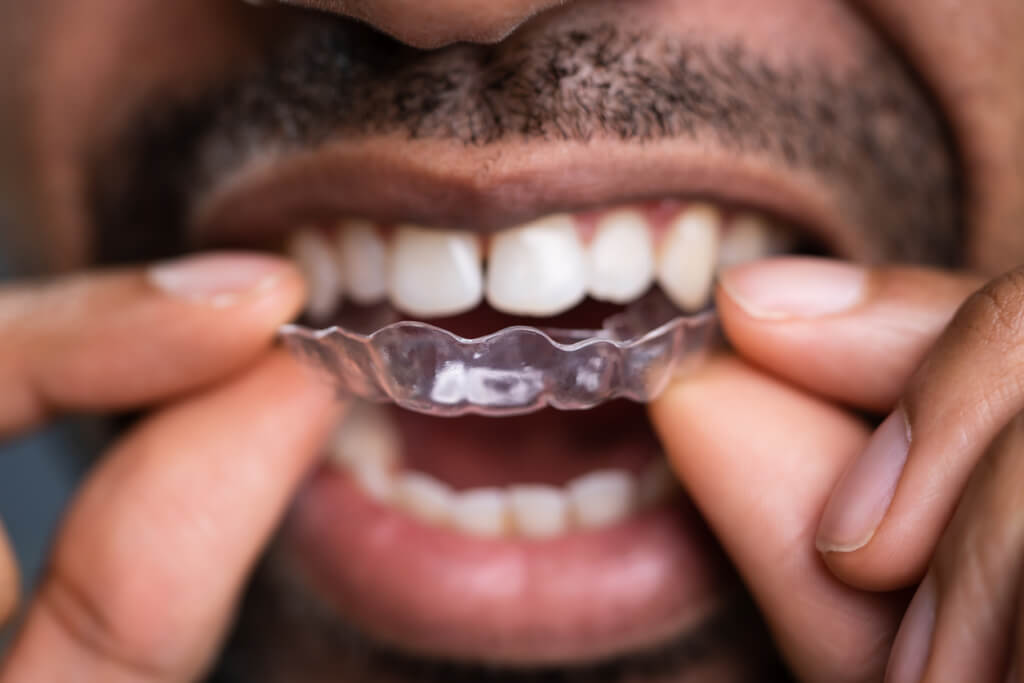Advertising Disclosure
Ceramic braces or Invisalign: Which clear braces are right for you?

When getting braces, most people are familiar with the classic metal braces. But for those who want a more discreet dental treatment, ceramic braces and Invisalign are popular options. The “clear” alternatives are especially popular among adults who don’t want the obvious metal braces. If you want to straighten your teeth and want a clear treatment, it can be difficult to choose between ceramic braces and Invisalign. The dental work you need can also play a huge factor when deciding between both options. While both are effective options, they are very different when it comes to how they work, maintenance and more. To help understand more about ceramic braces or Invisalign, keep reading.
What are ceramic braces?
While metal braces are still the most common, many people – adults, for the most part – choose ceramic for a less noticeable look. Ceramic braces, also known as clear braces, use clear brackets that blend in with your teeth, made of ceramic metal. Other than the clear bracket which is the biggest difference, ceramic braces work the same way as metal braces. An archwire controls the movements of your teeth and connects the brackets and bands. While they work the same, some patients report the clear braces being more comfortable and causing less scrapes than metal brackets. Ceramic braces are also a better clear option for those with more extensive cases, as Invisalign may not be an option for all., less damaging to your teeth, and can protect tooth enamel.
With advantages, come its disadvantages. Despite its clear appeal, studies show that ceramic braces discolor, and/or stain easily. Drinks like red wine, coffee and cola can stain your ceramic braces. These are braces are also less durable than the traditional option. This means you may have to pay extra, more regularly, if a bracket breaks.
Treatment length will vary from person to person, but ceramic braces are usually worn for somewhere between 18 months to three years.
What is Invisalign?
Invisalign is a popular orthodontic treatment that uses custom computer-generated aligners to straighten your teeth. Invisalign are the most transparent option. They make each aligner out of a flexible thermoplastic material called SmartTrack. These aligners apply pressure to your teeth, and shift them into place over time. Depending on your instructions, you should switch out aligners every week or two. One major difference that attracts people to Invisalign is the fact that they are removable. You can remove your aligners when eating, and when brushing and flossing your teeth. This allows for better hygiene compared to ceramic braces, which have large brackets that make brushing a bit trickier. Invisalign also requires less visits to the orthodontist office.
For the best results, you should wear your Invisalign aligners for 20 to 22 hours a day. Some see this as a con, because Invisalign requires you to be disciplined. The main reason why these aligners fail is due to patients not wearing them the proper way.
Despite its growing popularity, Invisalign may not be the right choice for everyone. Research suggests is more effective for those with less complex issues. Common (not severe) cases Invisalign can treat include crowded/crooked teeth, gapped teeth, overbite, underbite and open bite.
Ceramic braces or Invisalign: What is the cost?
Of course, cost is a major thing to take into consideration when deciding between ceramic braces and Invisalign. Regardless of the type of braces you’re getting, there is no doubt that it is a pricy investment. But it is important to note that both ceramic braces and Invisalign are more expensive than metal braces. Compared to traditional metal braces, ceramic braces can around $1,000 to $2,000 more. The traditional metal braces usually cost somewhere between $3,000 and $6,000. Most people believe Invisalign is the most expensive option, but it is close in cost to ceramic braces. An estimated base cost for Invisalign is about $3,000 to $8,000, while an estimated base cost for ceramic braces is about $4,000 to $8,000.
What factors affect the cost of these braces?
There are a lot of factor that can impact the cost of your braces. If you’re an adult getting braces, you’ll pay a bit more. This is because adults have larger teeth and larger oral cavities, which requires more material to make the braces. Cost also varies depending on health insurance. Certain health insurance companies may cover part of the cost for braces. According to Koerich Orthodontics, some insurance company’s can cover “a few thousand dollars,” and in some instances will save you “almost 50% of the cost.” Another cost factor is time. The length of time you will be wearing ceramic braces or Invisalign is going to impact the cost. On average, braces are worn for 24 months.
Whether you choose ceramic braces or Invisalign, you will not have to pay the full quote up front. You can divide the cost into a monthly payment plan based on how long you will need the braces.
Final thoughts
It is important to do your own research when decided what dental treatment is right for you, but for expert guidance on what’s best for you, set up a consultation with your orthodontist. Together, you can discuss the treatment you need, how long it’ll take, and, of course, a payment plan.







